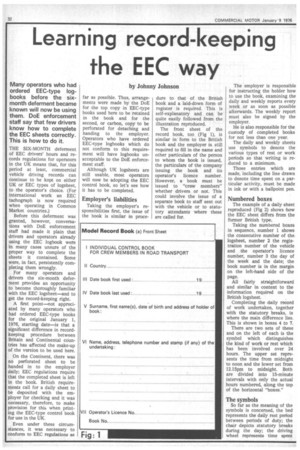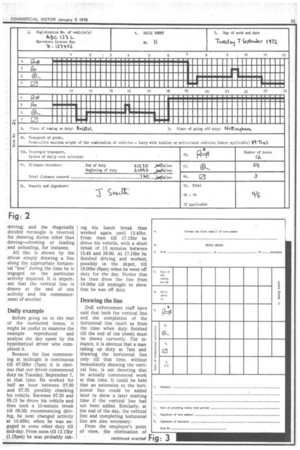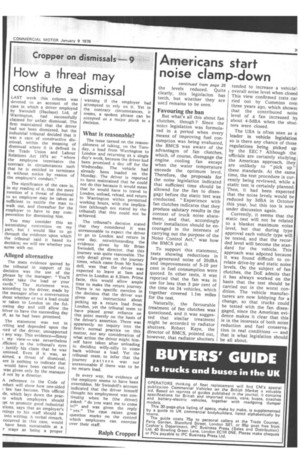Learning record-keeping
Page 34

Page 35

Page 37

If you've noticed an error in this article please click here to report it so we can fix it.
the EEC way by Johnny Johnson Many operators who had ordered EEC-type logbooks before the sixmonth deferment became known will now be using them. DoE enforcement staff say that few drivers know how to complete the EEC sheets correctly. This is how to do it.
THE SIX-MONTH deferment of EEC drivers' hours and records regulations for operators in the UK means that, for this period at least, commercial vehicle driving records can continue to be kept on either UK or EEC types of logsheet, to the operator's choice. (For international work an EEC tachograph is now required when operating in Common Market countries.) Before this deferment was granted, however, conversations with DoE enforcement staff had made It plain that drivers and operators already using the EEC logbook were in many cases unsure of the proper way to complete the sheets • it contained. Some were, in fact, persistently completing them wrongly. .
For many operators and drivers the six-month deferment provides an opportunity to become thoroughly familiar with the EEC logsheet—and to get the record-keeping right.
A first point—not appreciated by many operators who had ordered EEC-type books for the original January 1, 1976, starting date—is that a significant difference in recordkeeping procedure between Britain and Continental cduntries has affected the make-up of the version to be used here.
On the Continent, there was no perforated sheet to be handed in to the employer daily; EEC regulations require that the completed sheet is left in the book. British requirements call for a daily sheet to be deposited with the employer for checking and it was necessary, therefore, to make provision for this when printing the EEC-type control book for use in the UK.
Even under these circumstances, it was necessary to conform to EEC regulations as far as possible. Thus, arrangements were made by the DoE for the top copy in EEC-type books used here to be retained in the book and for the second, or carbon, copy to be perforated for detaching and handing to the employer. Operators who have ordered EEC-type logbooks which do not conform to this requirement will have logbooks unacceptable to the DoE enforcement staff.
Although UK logsheets are still usable, most operators will now be adopting the EEC control book, so let's see how it has to be completed.
Employer's liabilities Taking the employer's responsibilities first, the issue of the book is similar in proce dure to that of the British book and a laid-down form of register is required. This is self-explanatory and can be quite easily followed from the illustration reproduced.
The front sheet of the record book, too (Fig 1), is similar in form to the British book and the employer is still required to fill in the name and other particulars of the person to whom the book is issued, the particulars of the company issuing the book and its operator's licence number. However, a book must be issued to "crew members" whether drivers or not. This could involve the issue of a separate book to staff sent out with -the vehicle or to statutory attendants where these are called for. The employer is responsible for instructing the holder how to use the book, examining the daily and weekly reports every week or as soon as possible afterwards. The weekly report must also be signed by the employer.
He is also responsible for the custody of completed books for not less than one year.
The daily and weekly sheets use symbols to denote the various types of rest or work periods so that writing is reduced to a minimum.
Those entries which are made, including the line drawn to denote time spent on a particular activity, must be made in ink or with a ballpoint pen.
Numbered boxes The example of a daily sheet reproduced (Fig 2) shows how the EEC sheet differs from the former British type.
Taking the numbered boxes in sequence, number 1 shows the consecutive number of the.
logsheet, number 2 the registration number of the vehicle and the operator's licence number, number 3 the day of the week and the date; the book number is in the margin on the left-hand side of the page.
All fairly straightforward and similar in content to the information required on the British logsheet.
Completing the daily record of work undertaken, together with the statutory breaks, is where the main difference lies. This is shown in boxes 4 to 7. There are two sets of these and on the left of each is the symbol which distinguishes the kind of work or rest which has been involved over 24 hours. The upper set repre sents the time from midnight to noon and the lower set from 12.15pm to midnight. Both are divided into 15-minute intervals with only the actual hours numbered, along the top of the horizontal "boxes."
The symbols So far as the meaning of the symbols is concerned, the bed represents the daily rest period between periods of duty; the chair depicts statutory breaks during the day; the driving wheel represents time spent
Fig: 2
driving; and the diagonally divided rectangle is reserved for showing duties other than driving—sheeting or loading and unloading, for instance.
All this is shown by the driver simply drawing a line along the appropriate horizontal "box" during the time he is engaged on the particular activity depicted. It is important that the vertical line is drawn at the end of one activity and the commencement of 'another.
Daily example
Before going on to the rest of the numbered boxes, it might be useful to examine the example reproduced and analyse the day spent by the hypothetical driver who completed it.
Because the line commencing at midnight is continuous till 07.00hr (7am) it is obvious that our driver commenced duty on Tuesday, September 7, at that time. He worked for half an hour between 07.00 and 07.30, possibly checking his vehicle. Between 07.30 and 09.15 he drove his vehicle and then took a 15-minute break till 09.30; recommencing driving, be next changed activity at 10.45hr, when he was engaged in some other duty till mid-day. From noon till 13.15hr (1.15pm) he was probably tak ing his lunch break then worked again until 13.45hr. From then till 17.15hr he drove his vehicle, with a short break of 15 minutes between 15.45 and 16.00. At 17.15hr he finished driving and worked, possibly in the depot, till 18.00hr (6pm) when he went off duty for the day. Notice that he then drew the line from 18.00hr till midnight to show that he was off duty.
Drawing the line
DoE enforcement staff have said that both the vertical line and the completion of the horizontal line (such as from the time when duty finished till the end of the sheet) must be drawn current/y. For instance, it is obvious that a man taking up duty at 7am and drawing the horizontal line only till that time, without immediately drawing the vertical line, is not denoting that he actually commenced work at that time. It could be held that an extension to the horizontal line could be added later to show a later starting time if the vertical line had not been •added. Similarly, at the end of the day, the vertical line and completing horizontal line are also necessary.
From the employer's point of view, the elimination of
continued from page 25 the levels reduced. Quite clearly, this legislation has teeth, but whether they are used remains to be seen.
Favouring the ban
But what's all this about fan clutches, though ? Since the noise legislation was formulated in a period when every means of improving fuel consumption was being evaluated, the BMCS was aware of the advantages of fan clutches, which, of course, disengage the engine cooling fan except when the water temperature exceeds the optimum level. Therefore, the proposals for the noise legislation indicated that sufficient time should be allowed for the fan to disengage before the static test was conducted, "Experience with fan clutches indicates that they produce salutary results in the context of truck noise abatement, and that, accordingly their installation should be encouraged in the interests of carrying out the purpose of the Noise Control Act," was how the BMCS put it.
To support this statement, tests showing reductions in fan-generated noise of 20dBA and improvements of 5-10 per cent in fuel consumption were quoted. In other tests, it was reported that the fan was in use for less than 3 per cent of the time on 24 vehicles, which together covered 1.1m miles for the test.
Naturally, the favourable treatment of fan clutches was questioned, and it was suggested that similar treatment might be accorded to radiator shutters. Robert Kaye, the director of BMCS, pointed out, however, that radiator shutters tended to increase a vehicle': overall noise level when closed This view confirmed tests car ried out by Cummins ovel three years ago, which showec that the contributed 'foist level of a fan increased by about 4-5dBA when the shutters were closed.
The USA is often seen as a leader in vehicle legislation so is there any chance of these regulations being picked up by the EEC? Although •the officials are certainly studying the American approach, they are unlikely to "pick up" these standards. At the same time, the test procedure is currently being reviewed, while a static test is certainly planned. Then, it had been expected that the noise levels would be reduced by 3dBA in October this year, but this too is now under discussion again.
Currently, it seems that the static test will not be related to a blanket maximum noise level, but that during type approval each vehicle type will be tested, and that the recorded level will become the standard for the vehicle. This approach was adpoted because it was found difficult to corelate drive-by and static noise levels. On the subject of fan clutches, the DoE admits that it has always worked on the basis that the test should be carried out in the worst condition. The vehicle manufacturers are now lobbying for a change, so that trucks could be tested with the fan disengaged, since the American evidence makes it clear that this is in the interests of both noise reduction and fuel conservation in real conditions — and that is what legislation should be all about.




















































































